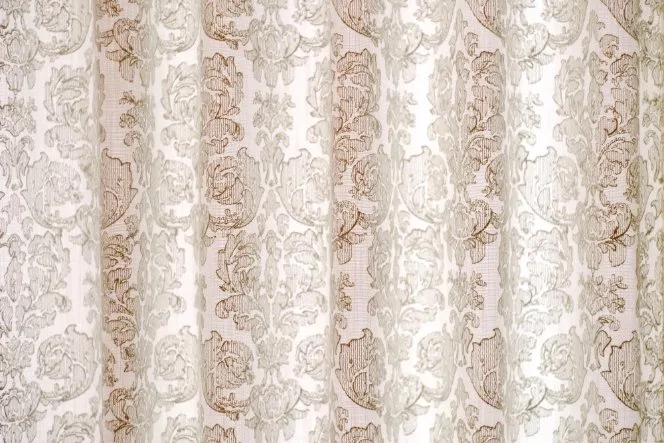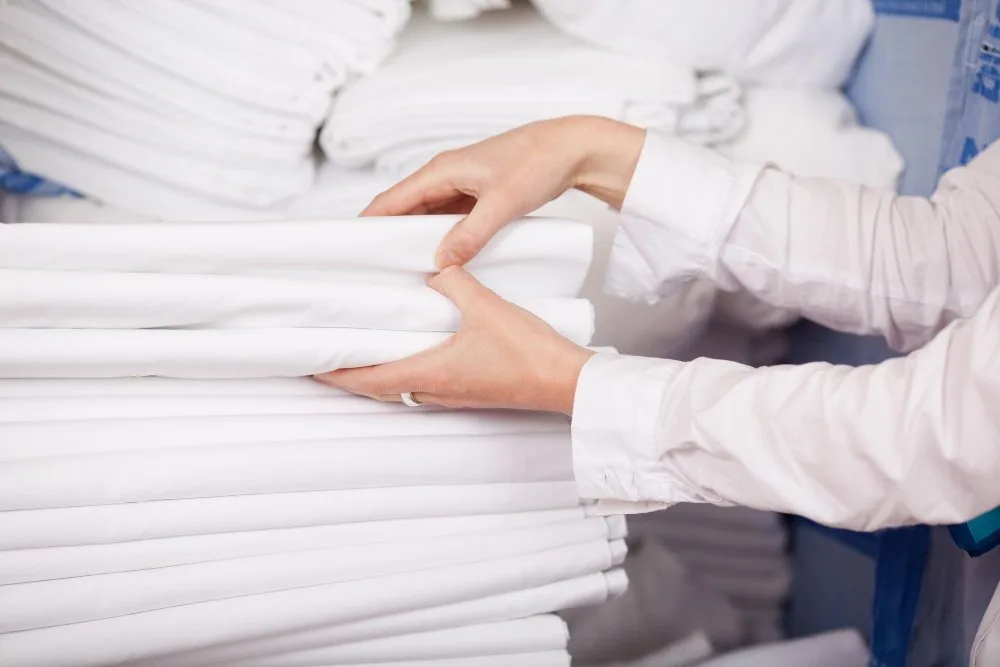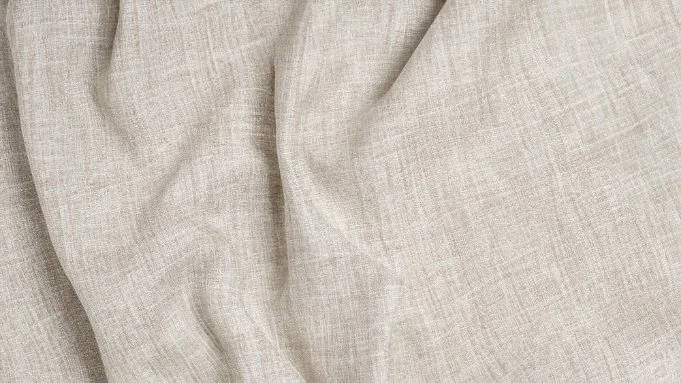Everything you need to know about damask linen, from ancient weaving techniques to modern home styling
Table of Contents
- What is Damask Linen Fabric?
- Types of Damask: Single vs. Double
- Quality and What to Look For
- Why Damask Linen is Sustainable
- Complete Care and Maintenance Guide
- Uses and Applications
- Buying Guide and Pricing
- Damask vs. Other Fabrics
- Pros and Cons of Damask
- Room-by-Room Styling Guide
- Common Mistakes to Avoid
- Frequently Asked Questions
- Conclusion
What is Damask Linen Fabric?
Damask (pronounced DAM-ask) is a reversible patterned fabric where the design is woven directly into the material, not printed on top. Unlike regular textiles where you see patterns through color or printing, damask creates its visual magic through the weave itself. Light hits the fabric at different angles throughout the day, making patterns appear and disappear like a living textile.
Here’s what makes damask special: the pattern is created by alternating between two weaving techniques. The design portion uses a satin weave (which reflects light), while the background uses a matte weave (which absorbs light). This contrast creates depth and dimension without needing multiple colors.
The Name and History
The name “damask” comes from Damascus, Syria, where this weaving technique flourished during the Middle Ages. While the technique likely originated in China around 300 BCE, Damascus became famous for producing these beautiful textiles during the Silk Road era. European crusaders discovered damask in the 11th century and brought it back home, where it quickly became a luxury item reserved for royalty and the wealthy.
By the 14th century, French and Italian weavers had mastered the technique. Ireland later became renowned for its linen damask, particularly for table linens that graced dining tables across Europe.
True Damask vs. Modern Damask
Originally, “true damask” meant fabric made entirely from silk. Today, the term applies to any fabric with this specific weaving pattern, regardless of fiber content. You’ll find damask made from:
- Silk – The original and most luxurious option
- Linen – Popular for table linens and curtains, known for durability
- Cotton – More affordable while maintaining quality
- Wool – Used historically for warmth
- Synthetic fibers – Modern options like rayon or polyester blends
According to textile historians, damask shows best in cotton and linen because these natural fibers have the right balance of body and drape to showcase the weave patterns.
Understanding Linen Types
When shopping for damask, you’ll encounter different linen grades. The three main types of linen quality are:
- European linen – Highest quality, grown in France, Belgium, Netherlands, and Ireland. Longer fibers create stronger, more durable fabric. This is what you want for premium damask.
- Standard linen – Mid-grade linen from various regions. Acceptable quality but shorter fibers mean less durability.
- Low-grade linen – Shorter fibers, looser weave, won’t hold up as well over time. Often mixed with other fibers.
When you see “100% linen,” this refers to fiber content only. The fabric could still be damask (the weaving pattern), plain weave, or any other construction. Similarly, “linen damask” means damask weaving done with linen fibers. Think of it this way: linen is the ingredient, damask is the recipe.
Types of Damask: Understanding Single vs. Double
Not all damask is created equal. Understanding the differences between types helps you make smarter buying decisions.
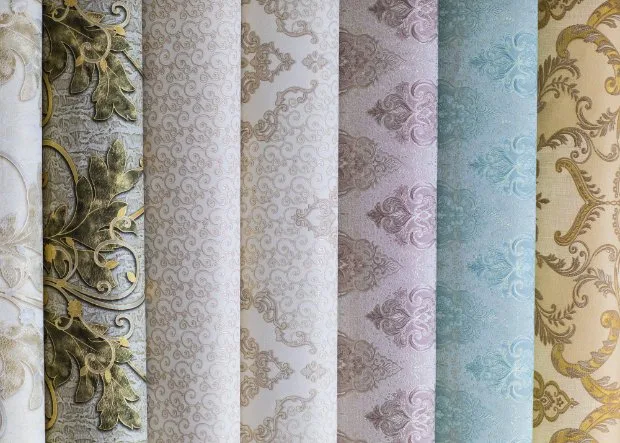
| Feature | Single Damask | Double Damask |
|---|---|---|
| Thread Count | 100-200 threads per inch | 165-400 threads per inch |
| Weave Structure | One warp set, one weft set | Two sets of finer yarns |
| Weight | Lighter, more breathable | Heavier, more substantial |
| Pattern Detail | Softer, gentler appearance | Sharp, crisp, highly defined |
| Best For | Everyday dining, casual use | Special occasions, formal settings |
| Durability | Good (with proper care) | Exceptional |
| Price Range | More affordable | Premium pricing |
| Sheen | Moderate luster | High luster, more reflective |
Important Note: Double damask doesn’t mean double weight or double strength. It’s a weaving term that refers to thread count and pattern complexity. A high-quality single damask can outlast a poorly made double damask.
Need help deciding? Use our Single vs. Double Damask Decision Tool to get a personalized recommendation based on your specific needs and budget.
Other Damask Classifications
Compound Damask: Uses multiple sets of warp and weft threads, allowing for three or more colors in the design. This creates more complex, multicolored patterns.
Twill Damask: Incorporates a twill weave (diagonal pattern) in either the ground or the design portion. This creates different textural effects compared to standard satin/plain weave combinations. According to textile encyclopedias, the warp in damask can pass over anywhere from two to nine fillings, creating varying degrees of luster.
What is Double Damask Irish Linen?
Irish double damask represents the pinnacle of linen craftsmanship. Ireland has been producing high-quality linen damask since the late 1600s when King William III established the industry there. Irish double damask specifically refers to:
- Linen woven in Ireland using traditional methods
- Minimum thread count of 180 threads per inch (anything lower is considered too loose for long-term use)
- Premium European flax fibers
- Patterns often featuring traditional Irish motifs like shamrocks or Celtic designs
Thomas Ferguson’s mill in Northern Ireland is one of the last remaining producers of authentic Irish double damask, maintaining centuries-old techniques while using modern computerized Jacquard looms for precision.
Quality and What to Look For When Buying
Knowing how to spot quality damask saves you money and ensures you get fabric that lasts decades. Here’s what to check:
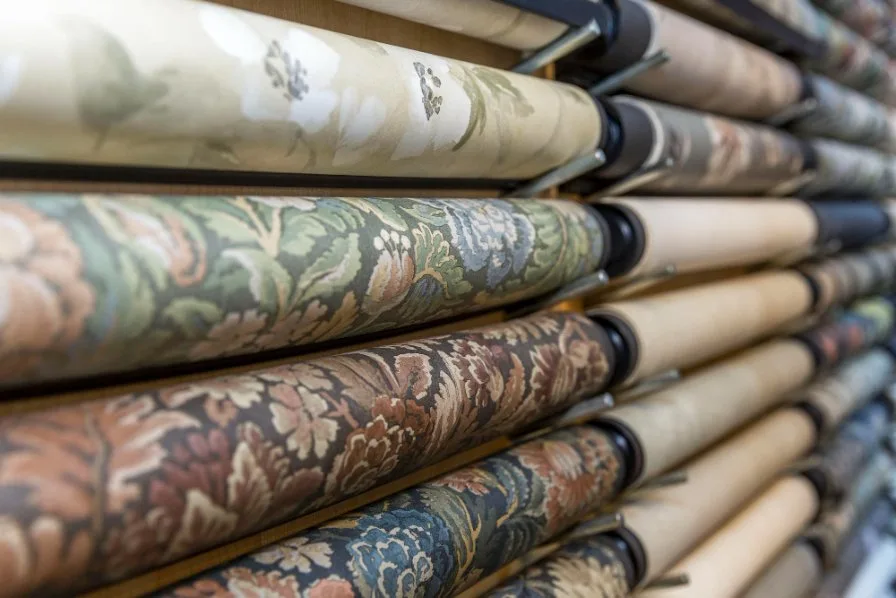
Thread Count Matters
Thread count is hard to fake in linen and cotton damask (unlike modern cotton sheets). Look for:
- Single damask: Minimum 150 threads per inch for decent quality
- Double damask: Minimum 180 threads per inch (below this, the fabric is too loose and will wear poorly)
- Premium double damask: 250-400 threads per inch
Higher thread counts create finer, more luminous fabric with better definition in the patterns.
Check the Weave Quality
Hold the fabric up to light. You should see:
- Even tension: No loose or tight spots
- Overwefting: Quality damask has more weft threads than warp threads, creating dense, durable fabric
- Sharp pattern definition: Designs should be crisp, not blurry
Red Flag: Under-wefted single damask (fewer weft threads than warp) will have threads that shift and separate over time. Avoid these unless you’re buying for short-term decorative use only.
Feel and Weight
Quality damask should feel:
- Substantial (has weight in your hand)
- Smooth with a noticeable sheen in the satin portions
- Crisp when new (it softens beautifully with washing)
Look for Mill Marks
Quality manufacturers weave tiny trademarks into the corners of tablecloths and napkins. These “mill marks” or “hallmarks” indicate:
- The fabric comes from a reputable producer
- It meets certain quality standards
- You can verify authenticity
Examine the Hem and Selvage
Even the best linen often leaves selvages raw and hems less than a quarter inch to preserve as much of the fabric as possible. This is normal and actually a sign of quality (every bit of that expensive damask matters!).
Shopping for damask? Download our comprehensive Damask Quality Assessment Checklist to verify thread count, weave quality, and spot red flags before you buy.
Why Damask Linen is One of the Most Sustainable Fabrics
If you care about environmental impact, linen damask deserves serious consideration. Here’s why it stands out as an eco-friendly choice:
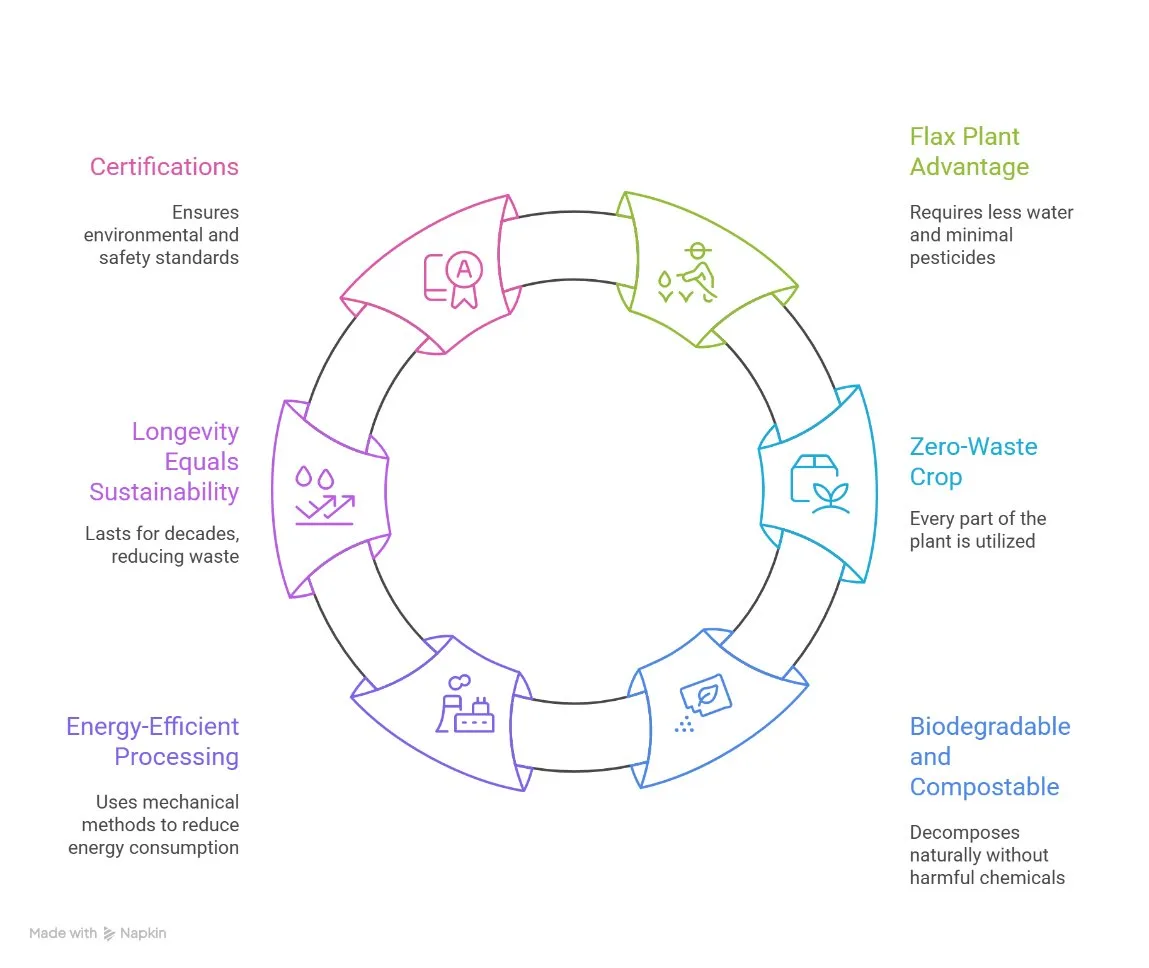
The Flax Plant Advantage
Linen comes from the flax plant, which has impressive sustainability credentials:
- Requires 13 times less water than cotton during cultivation
- Grows well with rainfall alone, reducing the need for irrigation
- Needs minimal pesticides and fertilizers
- Thrives in poor soil conditions while actually enriching the soil
- Second only to hemp as the world’s most productive crop per hectare
Zero-Waste Crop
Every part of the flax plant gets used:
- Long fibers become linen fabric
- Seeds produce linseed oil (used in paints and cooking)
- Shorter fibers become rope or paper (even banknotes and cigarette papers)
- Leftover plant material becomes animal bedding or natural insulation
Biodegradable and Compostable
When your linen damask eventually wears out (which takes decades), it breaks down naturally:
- Decomposes into organic matter without releasing harmful chemicals
- Actually enriches soil as it breaks down
- No microplastic pollution (unlike synthetic fabrics)
Energy-Efficient Processing
Processing flax into linen involves mechanical rather than chemical methods, which:
- Reduces energy consumption
- Lowers carbon footprint
- Minimizes chemical waste
Longevity Equals Sustainability
Quality damask linen lasts 20+ years with proper care. This longevity means:
- Fewer replacements needed
- Less textile waste
- Better value per use
- Reduced environmental impact over the product’s lifetime
Look for These Certifications
When buying sustainable linen damask, check for:
- European Flax® certification: Guarantees the linen comes from European cultivation (France, Belgium, Netherlands) with strict environmental standards including zero irrigation, zero GMO, and mechanical processing without chemicals. Learn more from the Alliance for European Flax-Linen & Hemp, the official certification body
- OEKO-TEX Standard 100: Ensures no harmful substances were used in production and the fabric is safe for human contact
- GOTS (Global Organic Textile Standard): For organic linen that meets the highest environmental and social criteria throughout the entire supply chain
Complete Care and Maintenance Guide
Proper care transforms good damask into an heirloom that lasts generations. Here’s everything you need to know:
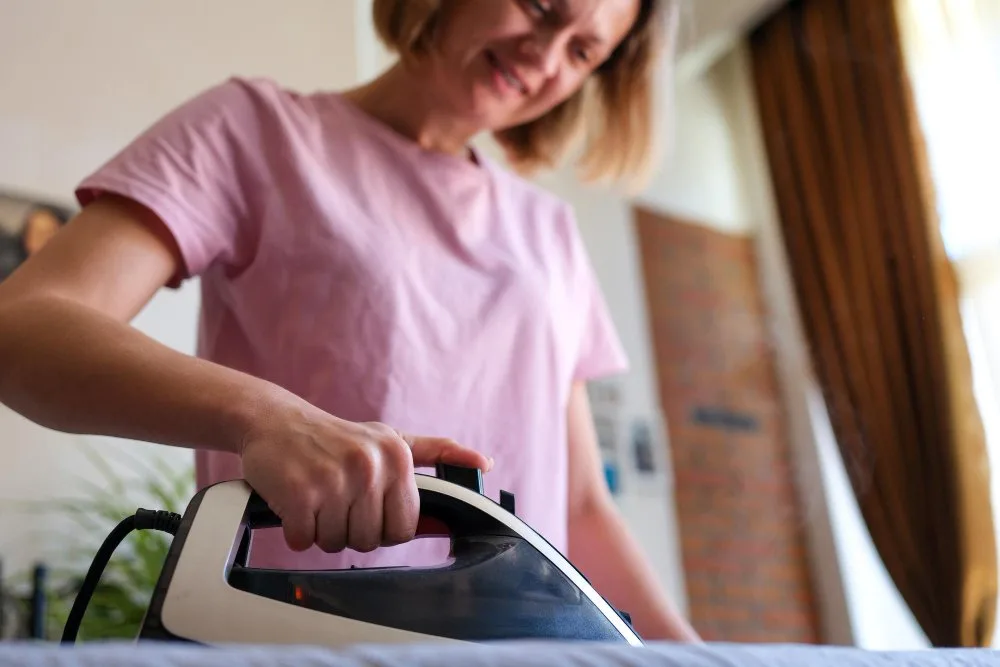
Get personalized care instructions: Use our Damask Care Calculator for customized washing temperatures, drying methods, and stain removal tips based on your fabric type.
First Wash
New damask has sizing (starch-like coating) that makes it stiff. The first wash removes this and softens the fabric.
- Shake out debris and dust
- Wash alone or with like colors
- Use gentle cycle with cold or lukewarm water (up to 40°C/104°F)
- Mild liquid detergent only
- Skip fabric softener (unnecessary for linen)
Regular Washing
Different fiber types need different care:
Linen and Cotton Damask
- Temperature: 60°C (140°F) is effective for cleaning; linen’s smooth fibers release stains easily
- Detergent: Mild, bleach-free formulas work best
- Machine settings: Gentle cycle
- Frequency: After 3-4 uses for table linens; curtains only need washing 1-2 times yearly
Avoid Bleach: Chlorine bleach yellows linen damask over time. For whites, use oxygen-based bleach (like OxiClean) instead, but test first on an inconspicuous spot.
Silk Damask
- Always dry clean
- Never machine wash
- Professional cleaning preserves the fabric’s integrity
Drying
How you dry damask affects its lifespan:
- Best method: Line dry in shade (direct sunlight can fade colors)
- Machine drying: Low heat only, remove while still damp
- Never: Over-dry on high heat (causes over-shrinkage and weakens fibers)
Ironing for Best Results
Here’s a secret: damask looks its absolute best when properly ironed.
- Iron while damp – This is the most important tip. If the fabric dried completely, lightly mist it with water
- Use medium-hot to hot iron setting (linen/cotton setting)
- Iron on the reverse side to protect the pattern and colors
- Press, don’t slide the iron (prevents distortion)
- Steam helps achieve a smooth finish
Many people skip ironing linen, but the fabric truly shines when pressed. The light reflection from smooth surfaces brings out the pattern beautifully.
Stain Removal Guide
Act quickly for best results. Here are solutions for common stains:
| Stain Type | Treatment | Important Notes |
|---|---|---|
| Coffee/Tea | Rinse with cold water immediately. Rub with clear dish soap, let sit 3-4 hours, wash normally | Hot water sets the stain permanently |
| Red Wine | Blot (don’t rub), sprinkle salt to absorb, rinse with cold water, treat with dish soap | Act within minutes for best results |
| Grease/Oil | Apply clear dish soap directly, let sit, wash in hottest safe water | Dish soap cuts grease effectively |
| Blood | Rinse immediately with COLD water (let water run through fabric). For old stains: soak in lukewarm water with dish soap for 30 minutes | Never use hot water – it sets blood permanently |
| Chocolate | Scrape off excess, apply dish soap, let sit 3-4 hours, wash normally | Let chocolate harden before scraping |
| Wax | Freeze the fabric, scrape off wax, place paper towels on both sides, iron over them to absorb melted wax | Change paper towels as they absorb wax |
| Mildew/Odor | Wash with white vinegar added to the cycle, or use Rodalon disinfectant following package directions | Address musty smells promptly |
For more detailed fabric care information, check out our complete linen care guide or use our Damask Care Calculator for personalized instructions based on your specific fabric.
Storage Tips
Proper storage prevents damage during off-seasons:
- Store in cool, dry place with good air circulation
- Avoid plastic bags or containers (they trap moisture)
- Don’t compress under heavy items (causes permanent creases)
- For vintage damask, lay flat or gently roll (folding can break delicate fibers)
- Cedar blocks or lavender sachets naturally repel moths without chemicals
Can You Machine Wash Damask?
Yes, most linen and cotton damask is machine washable. However:
- Always check the care label first
- Use gentle cycle to reduce stress on fibers
- Place items in a mesh laundry bag to prevent snags
- Wash similar items together (don’t mix tablecloths with towels)
Silk damask and garments with internal structures (like jackets) should be dry cleaned even if the fabric itself can be washed.
Uses and Applications: What is Damask Used For?
Damask’s durability and beauty make it perfect for both functional and decorative purposes.
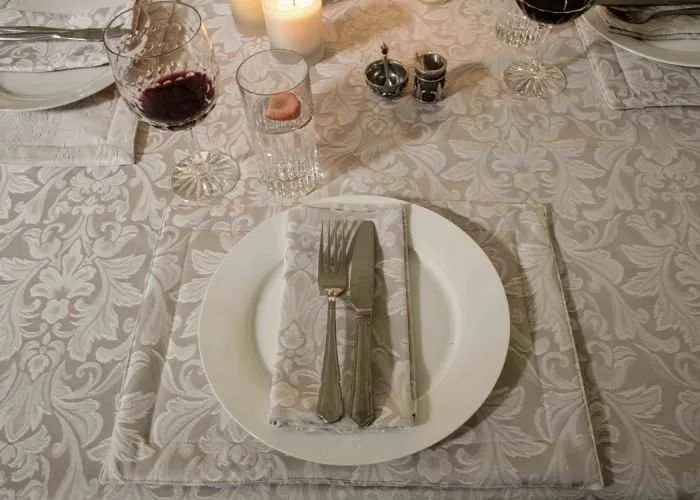
Table Linens
This is where damask truly shines. Damask tablecloths and napkins have graced dining tables for centuries because:
- The woven patterns won’t fade with washing (unlike printed tablecloths)
- Tight weave resists stains and spills
- Reversible design means both sides look equally good
- Gets softer and more beautiful with each wash
- Can withstand frequent laundering
Single damask works beautifully for everyday meals and casual entertaining. Double damask brings formality to special occasions, holidays, and dinner parties.
Window Treatments
Damask curtains and drapes offer several advantages:
- Natural weight creates structured, graceful folds
- Patterns shift appearance with changing light throughout the day
- Filters sunlight while maintaining privacy
- Breathable fabric allows air circulation
- Reversible design looks good from both inside and outside
Upholstery
Is damask an upholstery fabric? Absolutely. It’s actually one of the best choices for furniture because:
- Tight weave withstands daily wear
- Develops a softer patina over time (gets better with age)
- Two-tone patterns hide minor wear and stains
- Natural breathability prevents heat buildup on seats
- Works on everything from dining chairs to sofas
Look for damask with high double rub ratings (measures abrasion resistance) when choosing for upholstery.
Bedding
Damask sheets, duvet covers, and pillowcases offer:
- Temperature regulation (stays cool in summer, warm in winter)
- Gets softer with every wash
- Moisture-wicking properties
- Hypoallergenic (naturally resistant to bacteria and dust mites)
Fashion and Accessories
While less common than home textiles, damask appears in:
- Evening gowns and formal jackets (creates structured silhouettes)
- Scarves and shawls
- Handbags and clutches
- Neckties
The thick, structured nature of damask makes it better for stiff garments than flowing, draped clothing. Learn more about different fabric types and their uses in our comprehensive guide.
Decorative Accents
Beyond major applications, damask works beautifully as:
- Throw pillows and cushion covers
- Table runners
- Wall hangings
- Craft projects and upholstery repairs
Planning a project? Calculate exactly how much fabric you need with our Damask Yardage Calculator – accounts for pattern repeat, shrinkage, and provides cost estimates.
Buying Guide: Pricing and Value
Understanding damask pricing helps you budget and spot good deals versus overpriced items.
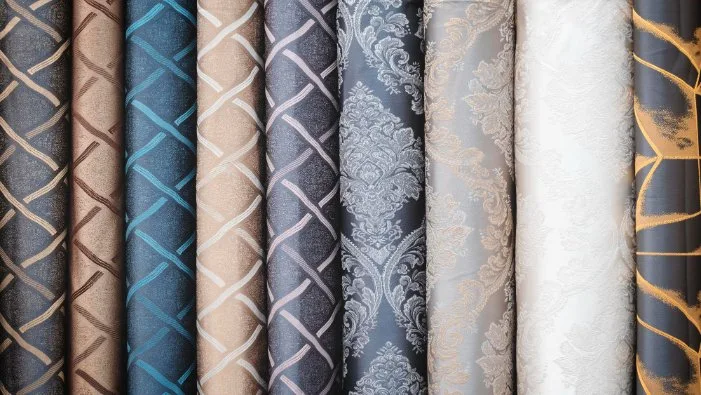
Is Damask Material Expensive?
It depends on fiber content and quality. Here are typical price ranges per meter:
- Silk damask: €50-150 ($55-165) – Most expensive
- Linen damask: €30-80 ($33-88) – Premium natural fiber
- Cotton damask: €20-60 ($22-66) – Mid-range
- Synthetic damask: €10-30 ($11-33) – Most affordable
Double damask commands premium pricing (often 30-50% more than single damask) due to higher thread counts and more complex weaving.
What Affects Price?
Fiber Quality: Long-staple fibers cost more but produce better fabric. European flax for linen damask is pricier than Asian alternatives.
Thread Count: Higher counts require more material and weaving time.
Pattern Complexity: Detailed designs with fine scrollwork or intricate florals cost more because they’re harder to weave.
Production Method: Hand-woven damask (very rare now) commands premium prices. Machine-woven is standard and more affordable.
Origin: Irish linen damask typically costs more due to reputation and quality standards.
Not sure what to look for? Our Damask Quality Assessment Checklist helps you verify you’re getting what you pay for, whether shopping online or in-store.
Is It Good Quality?
Quality damask is absolutely worth the investment. Here’s why:
- Lasts 20+ years with proper care (some families pass down damask for generations)
- Cost per use becomes minimal over decades
- Gets more beautiful over time
- Won’t fade or pill like printed or lower-quality fabrics
- Maintains resale value (vintage damask is collectible)
When to Splurge vs. Save
Spend more on:
- Table linens (high use = needs high quality)
- Upholstery (daily wear requires durability)
- Heirloom pieces you want to pass down
Save money on:
- Decorative pillows (less wear)
- Seasonal items
- Projects where you’re learning new skills
Planning your budget? Use our Damask Yardage Calculator to estimate exactly how much fabric you need and get projected costs before you buy.
Damask vs. Other Fabrics: Understanding the Differences
Confused about how damask compares to similar fabrics? Here are the key differences:
Damask vs. Brocade
Both use Jacquard looms and have woven patterns, but:
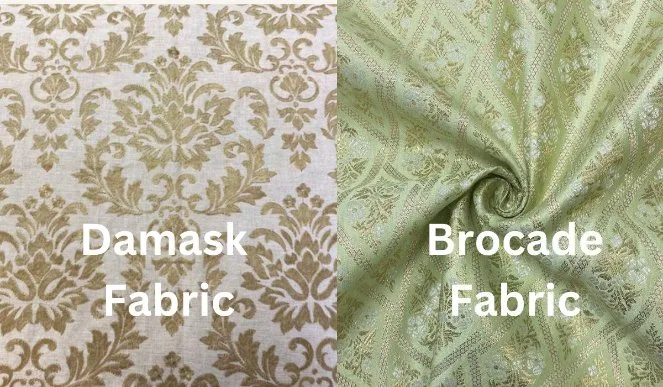
- Damask: Flat and reversible; patterns come from weave structure; usually monochromatic or two-tone; has lustrous satin sheen
- Brocade: Has raised, embossed patterns; not reversible; often multicolored; may use metallic threads; thicker and stiffer
Best uses: Damask for table linens and curtains; brocade for formal garments and decorative pillows.
Damask vs. Satin
This confuses many people since damask uses satin weave in its design:
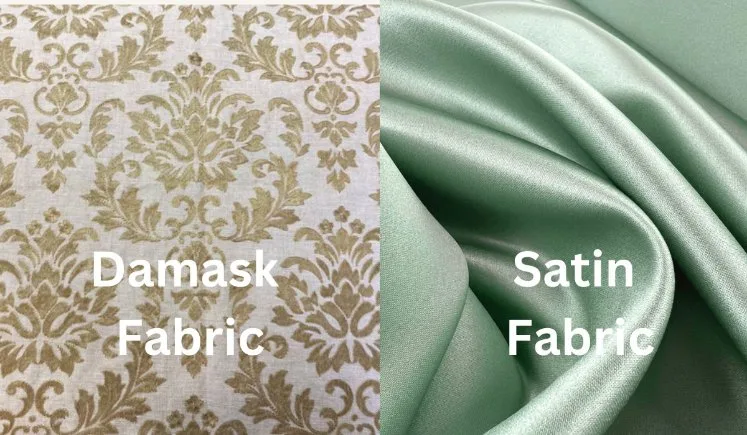
- Damask: Combines satin and matte weaves to create patterns; structured and substantial; reversible
- Satin: Smooth, glossy surface created by floating yarns; no pattern from weave; has distinct shiny front and dull back; drapes fluidly
Think of it this way: damask uses satin weaving as one component, while satin fabric is entirely that glossy weave. Learn more about the differences between fabric types in our comparison guides.
Damask vs. Jacquard
Here’s where it gets technical:
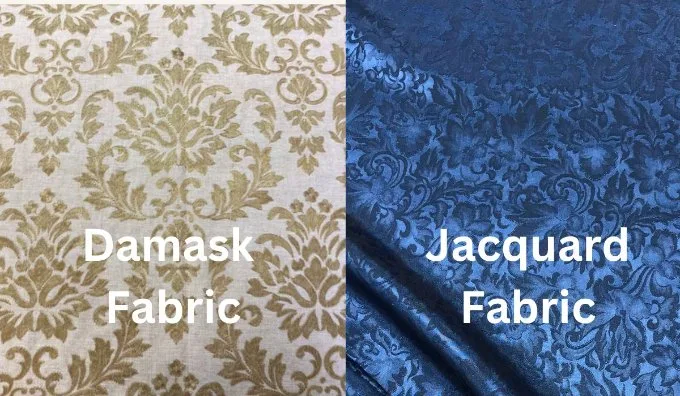
- Jacquard: A loom type that can create any woven pattern
- Damask: A specific type of fabric pattern that happens to be woven on a Jacquard loom
All damask is Jacquard, but not all Jacquard fabrics are damask. Jacquard looms can create brocades, tapestries, and many other woven patterns.
Damask vs. Velvet
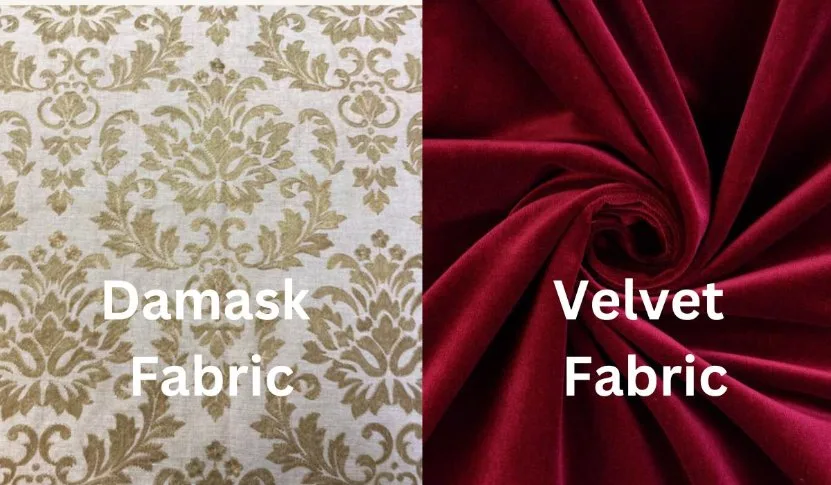
- Damask: Flat with lustrous sheen; refined texture; more durable; easier to maintain
- Velvet: Soft pile creates plush texture; rich depth; wears down faster; more prone to crushing and marking
When to choose damask: High-traffic areas, dining chairs, frequently washed items
When to choose velvet: Accent pieces, low-use decorative items, luxe feel priority
What Fabric is Similar to Damask?
If you like damask but want alternatives, consider:
- Matelassé: Quilted appearance, also reversible, similar weight
- Dobby weave: Simpler geometric patterns, less formal
- Damask-print fabrics: Much cheaper but patterns will fade (not true damask)
Pros and Cons: Is Damask Right for Your Needs?
Like any fabric, damask has strengths and limitations. Here’s an honest assessment:
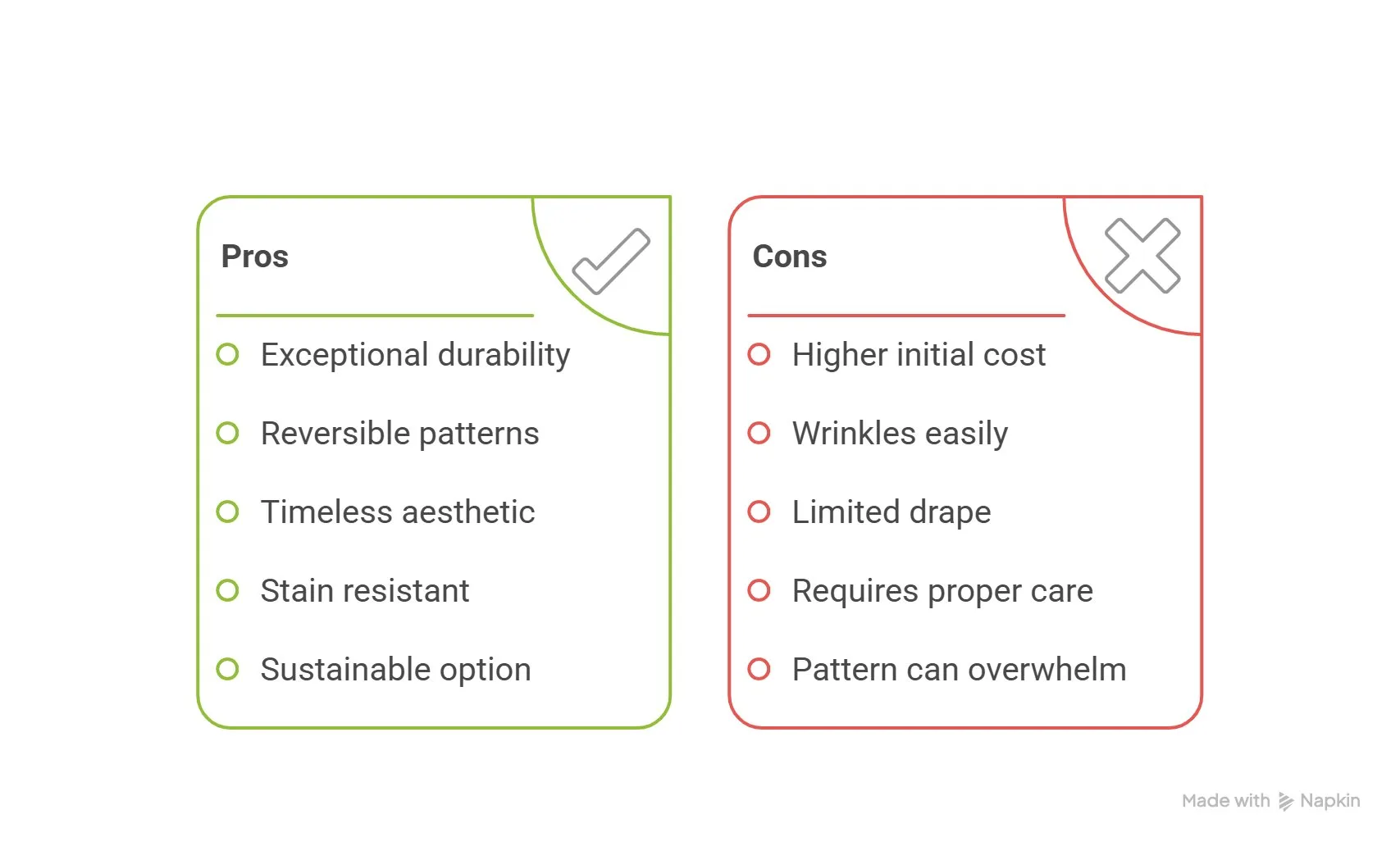
Advantages of Damask
- Exceptional durability – Quality damask lasts 20-30+ years, often becoming a family heirloom
- Reversible patterns – Both sides look equally good, extending usability
- Timeless aesthetic – Works in traditional and modern settings depending on pattern and color choices
- Gets better with age – Softens beautifully while maintaining structural integrity
- Stain resistant – Tight weave helps repel spills; two-tone patterns hide minor marks
- Sustainable option – Especially linen damask, which has minimal environmental impact
- Versatile applications – Works for table linens, curtains, upholstery, bedding
- Natural temperature regulation – Linen and cotton versions breathe well
- Low maintenance – Machine washable (most types) and becomes easier to care for over time
Disadvantages of Damask
- Higher initial cost – Premium damask requires significant upfront investment, though cost per use is low
- Wrinkles easily – Natural fiber versions need ironing for best appearance (though some embrace the relaxed look)
- Limited drape – Structured quality means it won’t flow like silk or chiffon for clothing
- Requires proper care – Incorrect washing or drying can damage the fabric permanently
- Pattern can overwhelm – Needs thoughtful use in interiors; too much creates visual chaos
- Limited availability – Quality damask, especially Irish double damask, is harder to find than mass-market textiles
- Fakes exist – Printed “damask-look” fabrics deceive buyers unfamiliar with real woven damask
The Bottom Line: Damask is worth the investment for items you’ll use frequently and want to last decades. For trendy, short-term decor, consider less expensive alternatives. Think of damask as buying quality once rather than replacing cheap items repeatedly.
Room-by-Room Styling Guide
Here’s how to use damask effectively throughout your home:
Dining Room
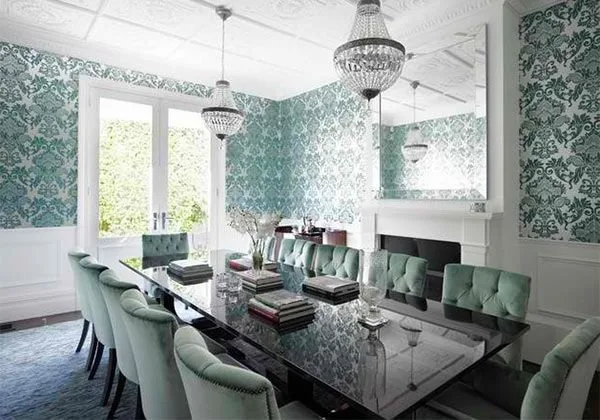
Classic Approach:
- White or ivory damask tablecloth for timeless look
- Matching napkins (consider two sets – everyday single damask and special occasion double damask)
- Table runner in coordinating color over solid tablecloth
Modern Twist:
- Black and white monochrome scheme creates drama
- Layer damask runner over simple white table covering
- Mix with contemporary elements (sleek dishware, modern lighting)
- Hang damask curtains with minimal pleating to show off patterns
Living Room
Less is more here to avoid overwhelming the space:

- Use damask on 1-2 accent pillows, not the entire sofa
- Choose subtle, tone-on-tone patterns for larger pieces
- Pair with solid fabrics in complementary colors
- Consider damask curtains as statement pieces
- Mix textures: damask with fleece or velvet prevents monotony
Bedroom
Damask adds luxury without fussiness:

- Headboard upholstery in rich damask creates a focal point
- Euro shams or decorative pillows (not necessarily full bedding)
- Window treatments in lighter damask for soft, filtered light
- Throw blanket at foot of bed
Traditional vs. Contemporary Styling
For traditional spaces:
- Choose floral or botanical motifs
- Stick with classic colors (ivory, gold, burgundy)
- Pair with antique furniture
- Layer with lace or other traditional textiles
For contemporary spaces:
- Select geometric or abstract patterns
- Use bold, modern colors (charcoal, navy, emerald)
- Keep patterns subtle and tone-on-tone
- Mix with clean-lined modern furniture
Common Mistakes to Avoid
Learn from others’ experiences and skip these common pitfalls:
Care and Maintenance Mistakes
❌ Using bleach on linen damask – Causes yellowing over time. Use oxygen-based alternatives instead.
❌ Over-drying on high heat – Shrinks fabric beyond recovery and weakens fibers.
❌ Skipping the iron – Damask looks mediocre when wrinkled but stunning when pressed. Take the extra few minutes.
❌ Storing in plastic – Traps moisture and can cause mildew. Use breathable fabric bags or wrap in acid-free tissue.
Buying Mistakes
❌ Assuming double damask is always better – Quality matters more than designation. Good single damask beats poor double damask.
❌ Buying printed “damask-look” fabrics – These are just printed patterns that will fade. Real damask has woven patterns that last forever.
❌ Ignoring thread count – Below 150 TPI for single or 180 TPI for double results in fabric that doesn’t hold up.
❌ Not checking fiber content – Drastically affects care requirements and longevity.
Styling Mistakes
❌ Too much pattern – Using damask on every surface creates visual chaos. Choose one or two statement pieces per room.
❌ Wrong scale – Large patterns overwhelm small spaces; tiny patterns get lost in large rooms.
❌ Ignoring reversibility – Flip cushions and curtains occasionally for even wear and fresh looks.
Frequently Asked Questions
Yes, damask remains popular because it bridges traditional and modern design. Contemporary damask features updated color palettes (charcoal, navy, emerald) and geometric patterns that work in modern interiors. The key is choosing the right pattern scale and color for your space. Tone-on-tone damask in neutral colors never goes out of style.
Damask has a long history, but it’s not inherently old-fashioned. The perception depends on pattern choice and styling. Floral damask in gold and burgundy reads as traditional. Geometric damask in modern colors feels contemporary. How you style it matters more than the fabric itself.
Yes, particularly in neutral colors and classic patterns. Quality damask survives changing trends because the woven patterns have depth and interest without being overly decorative. Many families use the same damask table linens for generations, proving its staying power.
Yes, especially linen and cotton damask. This is actually a sign of natural fibers. The solution is simple: iron while damp. Many people embrace the slightly rumpled look of linen as part of its charm, but for formal occasions, pressing brings out the pattern beautifully. Use our Damask Care Calculator for specific ironing temperature recommendations based on your fabric type.
It can be either. Traditional damask used natural fibers (silk, linen, cotton, wool). Modern versions may use synthetics like polyester or rayon, or blends. Check the label – “damask” describes the weaving pattern, not the fiber content.
Vintage damask refers to pieces typically 20-100 years old. These often feature hand-woven or early machine-woven construction, finer craftsmanship than many modern pieces, and traditional patterns. Vintage damask is collectible, especially pieces with mill marks from famous manufacturers. Handle with extra care – vintage fibers are more delicate.
Damask comes in any color. Traditionally, it was often white-on-white or single-color with pattern created through the weave’s light reflection. Modern damask includes everything from pastels to jewel tones to neutral grays and blacks. The pattern shows regardless of color because of the satin/matte contrast.
It varies. Single damask is lighter and more breathable. Double damask is denser and heavier. Both are more substantial than plain weaves but less heavy than velvet or tapestry. The weight makes damask excellent for structured applications like upholstery and formal table linens.
There’s no single “damask symbol.” If you’re seeing a symbol on damask fabric, it’s likely a mill mark (manufacturer’s trademark) or part of the decorative pattern. Common damask patterns include florals (roses, lilies), geometric designs, crests, and scrollwork.
All linen comes from flax. “European linen” specifically means flax grown and processed in Europe (primarily France, Belgium, Netherlands, Ireland). European linen is considered higher quality due to ideal climate conditions, strict production standards, and traditional expertise. Non-European linen may come from China, India, or other regions with varying quality standards.
This is like asking “what’s the difference between chocolate and cake?” Linen is a fiber (made from flax plants), while damask is a weaving pattern. You can have linen damask (damask pattern woven with linen fibers), cotton damask (damask pattern woven with cotton fibers), or even silk damask. Linen describes what it’s made from; damask describes how it’s woven. Many people use “damask” to mean “damask linen” because that’s the most common combination, but they’re technically different things. If you’re trying to choose between single and double damask linen, try our Single vs. Double Damask Decision Tool for a personalized recommendation.
European linen, particularly Irish and Belgian linen, represents the highest quality. Irish double damask with thread counts of 250+ threads per inch and European Flax certification is considered top-tier. Look for long-staple fibers, even yarn thickness, and traditional production methods.
Irish linen refers to linen woven in Ireland, particularly Northern Ireland. The difference lies in production standards and tradition. Irish weavers maintained damask techniques when other regions mechanized fully. Irish double damask must meet minimum thread count standards. The reputation for quality means Irish linen commands premium prices.
Jacquard linen (which includes damask) appears in table linens, curtains, upholstery, bedding, and decorative textiles. Any linen with a woven pattern (not just damask but also other designs) falls into this category. The complex patterns possible with Jacquard weaving make it popular for items where aesthetics matter.
Damask has been popular since the Middle Ages, with peak periods during the Renaissance (1400-1600), Victorian era (1800s), and the early 20th century when it became more affordable. It experienced a revival in the 1980s-90s and remains popular today in both traditional and contemporary design.
“Damast” is simply the German word for damask. They refer to the same fabric. You might see “damast” on European labels or when shopping internationally.
Conclusion
Damask linen fabric represents a rare combination of beauty, durability, and sustainability that few textiles can match. Whether you’re setting a formal dinner table, updating window treatments, or reupholstering a cherished chair, damask offers both practical performance and visual appeal that improves with age.
Key Takeaways
What Makes Damask Worth Considering
Longevity: Quality damask lasts 20+ years and often becomes a family heirloom. The woven patterns never fade, and the fabric actually gets softer and more beautiful with each wash.
Sustainability: Linen damask is one of the most eco-friendly fabric choices available. The flax plant requires minimal water and pesticides, every part gets used, and the fabric biodegrades naturally at end of life.
Versatility: From everyday meals to special occasions, casual contemporary spaces to formal traditional rooms, damask adapts to different settings through pattern and color choices.
Value: While initial cost may be higher than synthetic alternatives, cost per use over decades makes damask economical. You’re buying one tablecloth instead of replacing cheap ones every few years.
Making Smart Choices
Remember these priorities when shopping:
- Check thread count first – Minimum 150 TPI for single damask, 180 TPI for double damask
- Fiber content matters – Natural fibers (linen, cotton, silk) outlast and outperform synthetics
- Examine the weave quality – Look for even tension and sharp pattern definition
- Consider your actual use – High-traffic items need double damask; decorative pieces work with single damask
- Look for certifications – European Flax®, OEKO-TEX, or GOTS guarantee quality and sustainability
Care Determines Lifespan
Even the finest damask won’t reach its potential without proper care:
- Wash in appropriate temperatures (60°C for linen, follow label for others)
- Never use chlorine bleach on linen
- Iron while damp for best appearance
- Store properly in breathable containers
- Address stains quickly using appropriate treatments
Start Simple
If you’re new to damask, start with one quality piece:
- A set of napkins for special meals
- A table runner to layer over existing linens
- Two decorative pillows for your living room
- Simple curtain panels in a neutral tone-on-tone pattern
Experience how the fabric performs before investing in larger projects. You’ll discover why damask has remained popular for over a thousand years.
The Bottom Line
Damask isn’t just fabric – it’s a connection to centuries of textile tradition, a sustainable choice for modern homes, and a practical investment that pays dividends through decades of use. Whether you choose Irish double damask for heirloom table linens or modern geometric damask for contemporary curtains, you’re getting a textile that combines the best of traditional craftsmanship with timeless design.
The next time you sit down to a meal on a damask tablecloth or relax against damask cushions, you’re experiencing the same play of light and shadow, the same satisfying weight and texture that delighted medieval nobility and continues to bring simple joy to homes today.
Ready to start your damask journey? Use these helpful tools to make informed decisions:
- Single vs. Double Damask Decision Tool – Get personalized recommendations
- Damask Quality Assessment Checklist – Verify quality before buying
- Damask Care Calculator – Create a personalized care plan
- Damask Yardage Calculator – Calculate fabric needs for your projects
You can also explore our guides on natural versus synthetic fabrics to understand how damask compares to other textile choices.

